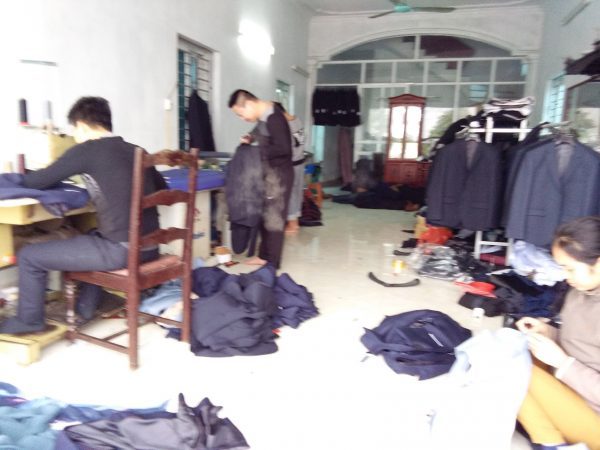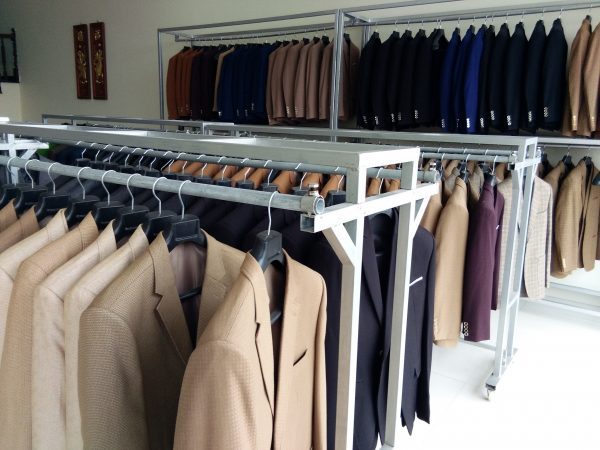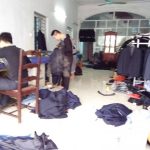Van Tu Garment Village’s reputation was established by the village’s first generation of tailors of Mr. Nguyen Van Hoa, Mr. Dao Thanh Du, Mr. Nguyen Lai, and many others. They were the ones who brought the profession of making suits as well as the exquisite techniques of garment to the village and helped create its well-known brand.
Van Tu people are always proud of the village’s hundred-year history. Initially, tailoring was not popular in Van Tu. In the old days, the village’s skillful men found ways to earn a living in other localities and brought their skillfulness to work. Many of them decided to stay in Hanoi and opened tailoring shops on Kham Thien Street, Bach Mai Street, Luong Van Can Street, Hang Gai Street, Hang Ngang Street, and so on. Around that time, suits were used only by upper class and the French and were not nearly as popular as they are nowadays. The sailor shops of Toan Thuan Anh, Toan Thuan Em, Thuan Thinh, and many others in Hanoi’s old quarters were all owned by people from Tu Thuan Village and Van Tu Village. Some time later, tailoring was lost gradually due to objective and subjective factors. Because of their love for tailoring, the tailors of Van Tu still carried their scissors and rulers around to work or opened their own tailoring shops.

Around the end of the 70s, suit tailoring began to be restored. In 1979, a garment skill contest held in Hanoi attracted the participation of people from all over the region, including the people of Van Tu (then part of the former province of Ha Tay). Mr. Nguyen Van Hoa of Van Tu Village, who only took 36 minutes to sew a shirt which was quicker than the second winner nearly 10 minutes, won the “golden scissors” title at the contest. He came back to the village to encourage people to open their tailoring businesses. In 1992, with the support of the authorities, the golden hand generation of the commune opened two courses of suit sewing for the youths. From those two courses with nearly 70 trainees, many young talented tailors of Van Tu were discovered. The first tailoring shops of Van Tu, namely Duy Hung, Thuan Dat, Thuan Toan, and Thuan Ha, were opened, paving the way for the flourishing of tailoring business in the area. The brand of Van Tu suits gradually grew stronger and got known to consumers all over the country.
Currently, Van Tu Commune has 10 villages and all 10 have their own garment businesses, most of which are in Chung Village (about 90% of households) and Tu Thuan Village (over 99% of households). About 70% of the commune’s households make suits or other garment products for a living. From having to make mass merchandise or process for large shops in Hanoi, Ha Dong, Ha Nam, Nam Dinh, or operate small businesses, the new generation of Van Tu nowadays own garment cooperatives, garment enterprises, garment processing workshops, and well known limited liability companies having from a few tens to hundreds of workers making high-end suits. Van Tu tailors also open shops and agents in several provinces and cities in the country, from Lam Dong Plateau to Sai Gon, from Hanoi to Can Tho, Nam Dinh, and Hai Duong. Big suit workshops and shops bearing the brand name of Van Tu have been established everywhere. Van Tu’s garment is not only available all over the country, but also exported to many countries in Asia and Europe.

A garment workshop and showroom at Van Tu Village
To be able to make a suit, a person must undergo many years of apprenticeship training. In the first 6 to 12 months, a tailor must learn to master the techniques of nipping, attaching buttons, and cutting thread. The next few years are spent to master the technique of sewing sleeves, sewing different components together, and completing a suit. The final stage is learning to sew pants. It takes about 10 years for a new suit tailor to become a skillful one. The more experienced the tailor is, the more skilled he/she becomes as most of the skills are learned through the work. A skillful tailor can tell straight away which type of sewing technique needed to be applied to make a standard suit that matches a given customer’s body shape and earns compliment from ten out of ten people. Suits made by Van Tu tailors stand out with their four layers of components: cloth, netting, lining layer, and cotton. These four layers make the suits thicker, more durable, and less creased.
Van Tu of today is in its fifth generation of suit tailoring. Many families have three or four generations of tailors, such as the family of Mr. Nguyen Anh Tuan with three generations. His grandfather used to run a tailoring shop in Mai Huong Lane. At present, his garment workshop has about 30 workers with an average income of skilled workers exceeding VND 10 million per month. Each year, his workshop provides about 300-400 high-end suits for domestic market use. Mr. Nguyen Van Cuong, 39 years old, owns a garment workshop of nearly 40 workers that provides a yearly number of suits of from 600 to 700 for domestic market use and for export to Russia. His family has four generations of tailors, starting with his great-grandfather who ran an early-20th-century tailoring shop on Kham Thien Street. The village also has many second-generation tailors, such as veteran Dao Ngoc Hung, director of Huy Hung Garment Private Enterprise. The enterprise has been awarded a Golden Award by the Vietnam Business Association and the director himself has been awarded a Certificate in Honor of Golden Veteran-turned-entrepreneurs of 2008 -2009. His father used to run a tailoring shop on Hang Gai Street. The enterprise’s high-end suits are mainly exported to foreign countries.
Winter comes with cold winds and north-east monsoon, bringing suit tailors’ golden season to the village. Around this time, the demand for tailoring suits of the people gets enormous. Van Tu keeps getting orders from Hanoi and other provinces and cities from all over the country. The whole commune is busy, hustle and bustle day and night with cutting, sewing, and delivering. Suits keep getting made with each one of them carrying great care of Van Tu tailors, beautifying the world, and enriching the families and the homeland of the tailors.
With pride in the products of the homeland, at Phu Xuyen District’s Traditional Craft Village Honoring Festival, Van Tu people brought a giant suit that was recorded in the Guinness Book of Records to introduce to and amaze visitors.
Thanh Quy

